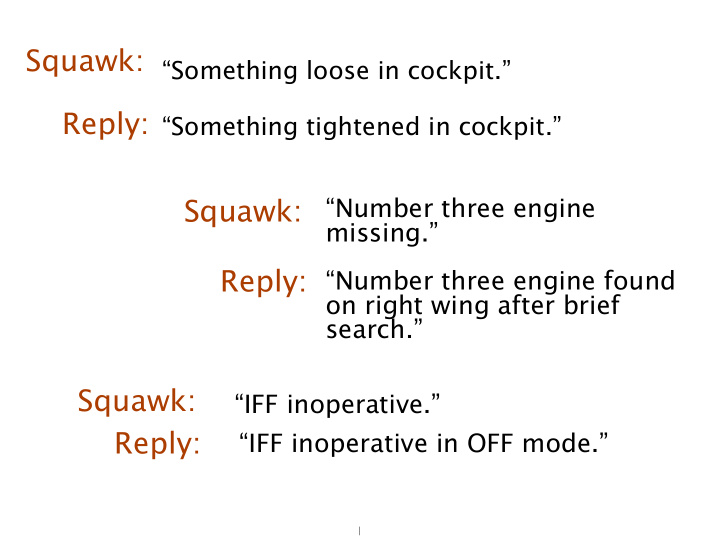



Squawk: “Something loose in cockpit.” Reply: “Something tightened in cockpit.” “Number three engine Squawk: missing.” Reply: “Number three engine found on right wing after brief search.” Squawk: “IFF inoperative.” Reply: “IFF inoperative in OFF mode.” 1
ONWARD! 2
communication What causes misunderstanding? What can we do about it? collaboration What makes for intelligent teams? What can we do about it? ONWARD! 3
HOW WILL YOU IMPROVE? - Participate in class - Participate with each other - Experiment (risk, be uncomfortable, make mistakes) - Ask questions - Observe - Ponder A LOT LIKE LEARNING SAXOPHONE! 4
Emotional Intelligence Framework Social empathy Self Awareness Awareness Self- Relationship Management Management Positive Impact On Others Daniel Goleman, The Brain and Emotional Intelligence 5
Collaboration and Self-Awareness Close your eyes (for just a minute). 6
Collaboration and Self-Awareness Everyone is not like you. Some people are like you. (how does this affect your collaboration?) 7
Collaboration and Self-Awareness We readily recognize our mistakes. We don’t so readily recognize our successes. (how does this affect your collaboration?) 8
Collaboration and Self-Awareness We are hard-wired for fight or flight. 9
MIT Professor Rebecca Saxe has shown that the TPJ is active when you think about other people’s thoughts! 10
So what happens when you perceive others? 11
data adapted from Chris Argyris, Overcoming Organizational Defenses. Prentice-Hall, 1990.. 12
data ??? adapted from Chris Argyris, Overcoming Organizational Defenses. Prentice-Hall, 1990.. 13
data select* *based on past, interests, training, culture, mood, need, etc.... adapted from Chris Argyris, Overcoming Organizational Defenses. Prentice-Hall, 1990.. 14
data select* compare right interpret wrong stupid smart evaluate good bad adapted from Chris Argyris, Overcoming Organizational Defenses. Prentice-Hall, 1990.. 15
data select* compare interpret evaluate oh no!! conclude act adapted from Chris Argyris, Overcoming Organizational Defenses. Prentice-Hall, 1990.. 16
data select* compare interpret evaluate oh great!! conclude act Chris Argyris and Peter Senge dubbed this the “ladder of inference.” adapted from Chris Argyris, Overcoming Organizational Defenses. Prentice-Hall, 1990.. 17
So a large part of developing self-awareness is becoming aware of yourself leaping up your ladder of inference, then learning to slow yourself down, and eventually to evaluate more objectively. 18
THINK OF ONE OF THOSE THINGS YOU SCREWED UP. THEN CLOSE YOUR EYES. 19
IMAGINE THAT IT’S • right • wrong • good • bad • stupid • smart • better • worse The purpose of this exercise is to increase your ability to think flexibly about your point of view. 20
So what? What does this have to do with… - how we view the world? - how we listen to each other? - how we influence each other? - how we respond to each other? 21
Everyone please stand up. a brief interlude on presentation… 22
THEN HOW ABOUT TEAMS? DO TEAMS HAVE A COLLECTIVE INTELLIGENCE FACTOR, SIMILAR TO IQ IN INDIVIDUALS?? Apparently, YES! 23
Evidence for a Collective Intelligence Factor in the Performance of Human Groups* . Anita Williams Woolley, et al. Study 1. 40 3-person groups Study 2. 152 2- to 5-person groups Range of 5-10 tasks: puzzles, moral judgments, negotiating… * Science, 29 October 2010: Vol. 330 no. 6004 pp. 686-688. 24 DOI: 10.1126/science.1193147
Evidence for a Collective Intelligence Factor in the Performance of Human Groups . Anita Williams Woolley, et al. “In predicting performance on the criterion task, c [collective intelligence factor] has a significant effect, but average individual intelligence and maximum individual intelligence do not. 25
Fig. 1 Standardized regression coefficients for collective intelligence (c) and average individual member intelligence when both are regressed together on criterion task performance in Studies 1 and 2 (controlling for group size in Study 2). A W Woolley et al. Science 2010;330:686-688 Published by AAAS 26
Evidence for a Collective Intelligence Factor in the Performance of Human Groups . Anita Williams Woolley, et al. So what comprises this c ? NOT: average or maximum individual IQ NOT: group cohesion, motivation, or satisfaction 27
Evidence for a Collective Intelligence Factor in the Performance of Human Groups . Anita Williams Woolley, et al. So what comprises this c ? 1. average social sensitivity of group members 2. variance in the number of speaking turns by group members, 28
HOW MIGHT C (COLLECTIVE INTELLIGENCE), RELATE TO EI (EMOTIONAL INTELLIGENCE)? 1. average social sensitivity of group members 2. variance in the number of speaking turns by group members, 29
HOW MIGHT C (COLLECTIVE INTELLIGENCE), RELATE TO EI (EMOTIONAL INTELLIGENCE)? back to Self-Awareness…. 30
So what? - realizing others come with different outlooks CURIOSITY - adjusting your own perspective 31
HOMEWORK • By next Friday’s Forum, summarize your self-assessment with your teammates: • what are three or four things that you want to work on with regard to your communication and collaboration in this class? • Use the good/bad exercise with two or three times: share your learning with your team, and, in a brief email, with me. CURIOSITY LISTEN! 32
Photo: NASA; JPL To go fast, go alone. To go far, go with others. Proverb, source unknown. 33
Let’s practice :-) Get in your teams Take __ minutes Tell each other two or three things you want to improve with regard to your presenting Make a preliminary plan for preparing your briefing: roles and responsibilities schedule 34
Recommend
More recommend